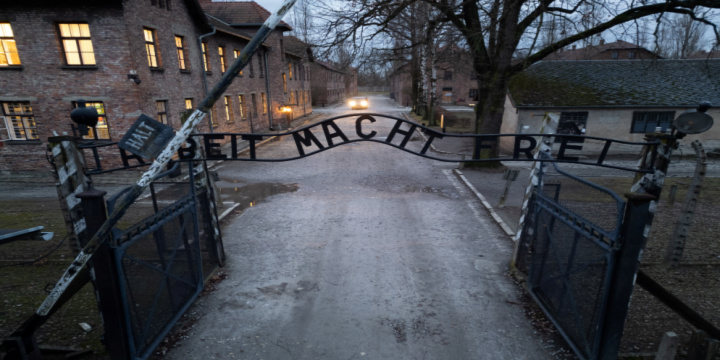A drone view of the “Arbeit macht frei” gate at the former Auschwitz concentration camp ahead of the 80th anniversary of its liberation, Oswiecim, Poland, Jan. 10, 2025. Photo: REUTERS/Kacper Pempel
Dr. Gregory Stanton, founder of Genocide Watch, argues that genocide unfolds through a ten-step process. It begins with early warning signs like discrimination and dehumanization, then escalates into violent persecution and extermination. But Stanton’s final stage might come as a surprise. He says genocide culminates with denial, and that denial is an integral part of the process itself.
Of course, denial can help relieve the conscience of the perpetrators, or be part of their efforts to shield themselves from legal culpability. But according to Stanton, denial is actually a final act of violence towards the victims. It completes their destruction by assaulting even the memory of the victim group, causing not only further psychological anguish but also cultural erasure.
This last step the Nazis were largely unable to achieve. How they singled out, persecuted, and ultimately mass murdered Jews is on display in museums worldwide. Jewish youth return to Auschwitz each year for the March of the Living, keeping the death camps and the memory of what took place there preserved.
But where the Nazis failed, the United States’ largest teachers’ union now aims to succeed.
The National Education Association (NEA), which represents nearly three million public school teachers, just released a new handbook instructing teachers to no longer tell their classes that Jews were the primary target of the Holocaust. Instead, they are now supposed to say that the Nazis killed “millions of victims of different faiths.”
The fact that Jews were taken to the gas chambers solely because of their religion is to be covered up; that the Holocaust was an assault on European Jewry is something they want to erase.
Why the change? The political context makes it clear. In the NEA’s view, the memory of Jewish persecution at the hands of the Nazis is being improperly used to exempt Israel from scrutiny over its conduct in Gaza, and the legacy of the Holocaust is causing undue hesitation in accusing Israel of genocidal conduct.
Believing that Jewish persecution by the Nazis has been misappropriated in defense of Israel, the NEA seeks to sever this link between the Holocaust and Jews.
And of course, they have a point about how history can be misused. Clinging to historical grievances often fuels efforts to correct past injustices. And all too easily, that impulse can lead to inflicting new injustices on others
But the NEA seems to have no such compunctions when it comes to the history of Palestine. The new manual goes into great detail about “the Nakba.” Teachers are to tell students that the establishment of the State of Israel resulted in the violent, forced displacement of at least 750,000 Palestinians from their homeland. They claim this is important in order to help understand what they call the ongoing trauma of Palestinian Americans today.
But doesn’t this kind of Nakba education risk inflaming tensions and fueling further violence? By their logic, wouldn’t it be better to offer a more generic description — something like, “When the State of Israel was established, some people of various ethnicities relocated to new places.”
After all, history has shown us that the ongoing effort by many Palestinians to rectify what they perceive as the injustice of 1948 has repeatedly led to violence against Israelis and Jews.
It seems that the NEA’s real aim is not to revise history in order to defuse its potential for fueling violence in the present, but rather to weaponize it in support of the Palestinians’ cause against Israel. Unfortunately, this will only plant the seeds for more conflict in the future.
We can’t achieve peace by denying the history or suffering of others. That only deepens resentment and hatred — and eventually, it will resurface. The path to peace begins with a willingness to face the past honestly: to acknowledge the pain, injustice, and harm both experienced and inflicted by all sides. From that shared reckoning, the foundations of peace can finally take hold
Memory of the Holocaust certainly should not be used to exempt Israel from legitimate criticism or scrutiny. But the solution is not to deny that the Holocaust was an attempt to destroy the Jewish people. Instead, we have to make sure that when we say never again, we mean never again for anyone — not for us, not for Palestinians, not for anyone else.
Shlomo Levin is the author of the Human Rights Haggadah, and he uses short fiction and questions to explore human rights at https://shalzed.com/
Click this link for the original source of this article.
Author: Shlomo Levin
This content is courtesy of, and owned and copyrighted by, https://www.algemeiner.com and its author. This content is made available by use of the public RSS feed offered by the host site and is used for educational purposes only. If you are the author or represent the host site and would like this content removed now and in the future, please contact USSANews.com using the email address in the Contact page found in the website menu.








